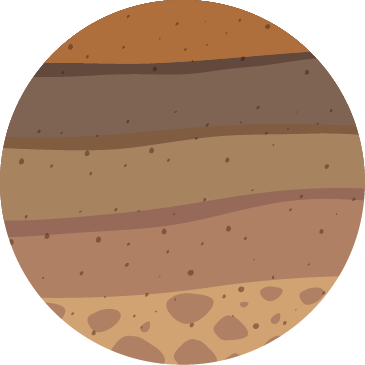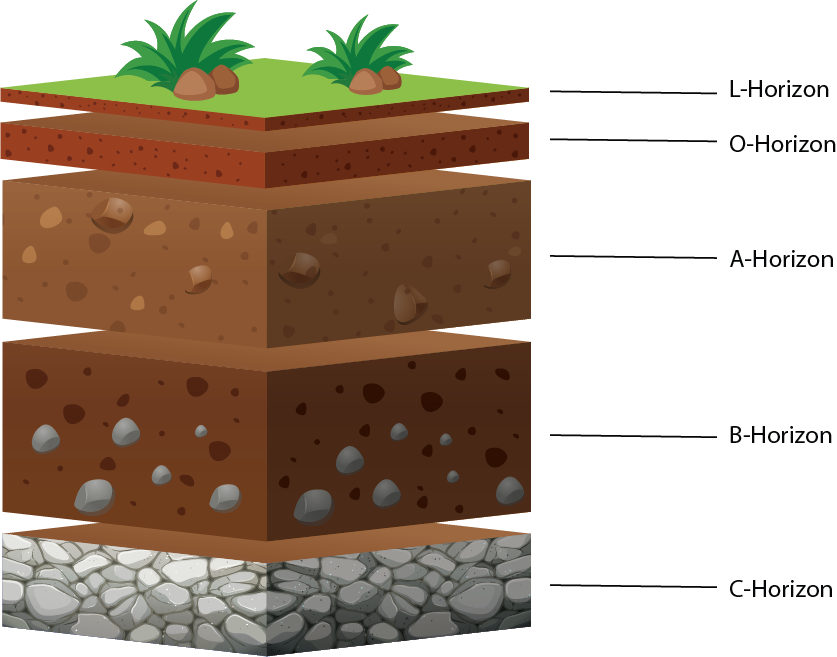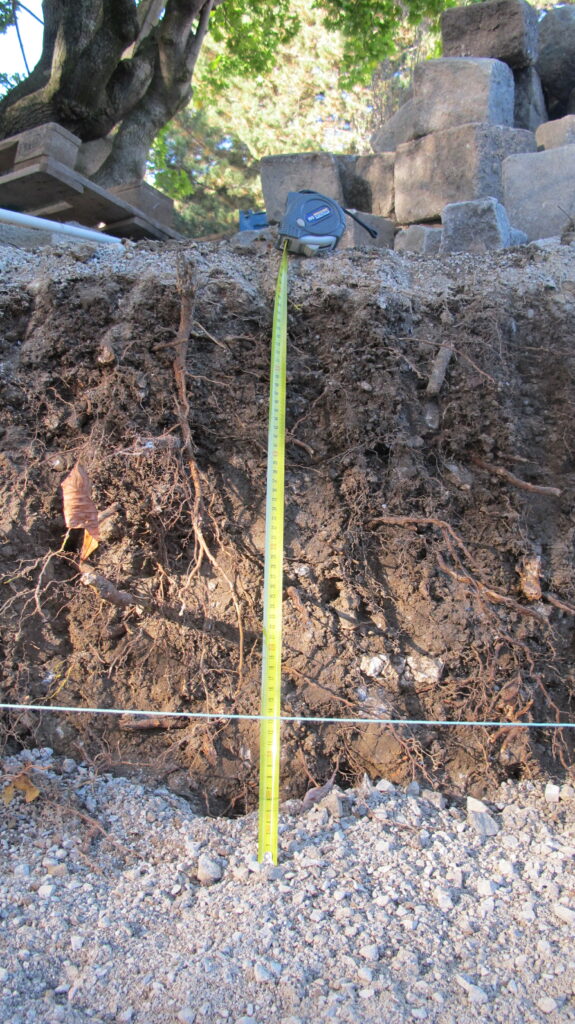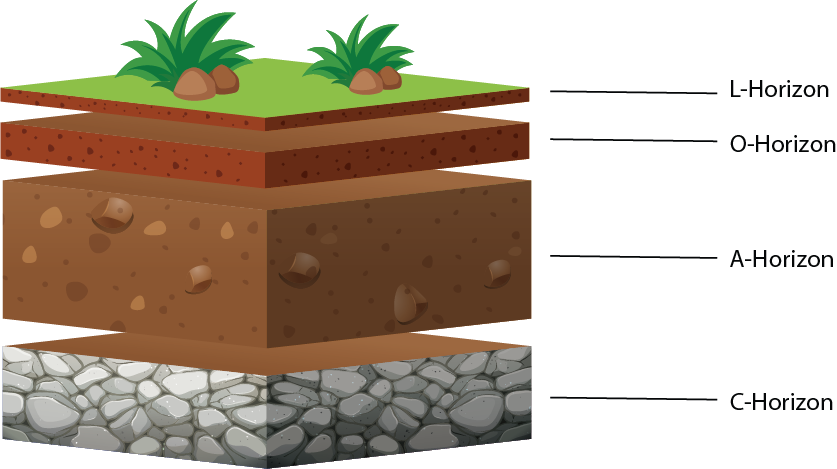Contents of this page
Soil types
What are the differences?

Sandy, loamy or silty? The composition of soils is defined by the grain size composition of the mineral soil substance and the associated tactile properties. Depending on the grain size composition, soils can store different amounts of water, have a different nutrient content, are difficult or easy to work and are rooted differently by plants.
BENEFITS FOR GREEN COOL SCHOOLS

- Get to know the growing conditions of the school yard or area from the viewpoint of soil and find the best spots for plants.
- Get to know different soils and recognise differences.
- Gain an understanding of which soil types are good for greening and how the soil can be improved if necessary.
Soil types
Soil types are roughly divided into sandy, loamy, silty, and clayey soils. In addition, there are intermediate levels where the main component of the soil gives the soil its name. For example, “sandy clay” or “loamy sand”.
Clay soils
… are heavy, moist to wet soils with consistently fine grain size (< 0.002 mm). They can absorb a lot of water. Seepage water is released only slowly, often resulting in waterlogging when it rains. Plant roots can only grow and breathe only with difficulty in these soils, which leads to a low absorption of water and nutrients.

Loamy soils
… contain all three grain fractions, i.e., sand, silt, and clay. Apart from a relatively balanced grain size mixture, the dominant grain fraction determines its predominant characteristics (e.g., sandy loam soils). Upward water drainage and water holding capacity are well developed. Loamy soils have a high nutrient content. Disadvantages, especially with heavy loamy soils, are poor aeration and the difficulty of working with it, agriculturally. In addition, the warming of loamy soils in spring is rather slow. “Lighter”, and thus better, aerated loamy soils are very suitable as agricultural and garden soils. The mealy soil particles in loamy soils are silt particles (0.002 to 0.063 mm) and stick to the finger creases.

Sandy soils
… have a one-sided proportion of coarse grains (0.063 to 2 mm). They are easy to work, but usually low in nutrients. Due to the coarse grain size, the soil is well aerated, easy to root through and warms up quickly. Although it can absorb a lot of water, it can only store it poorly.

Soil structure and horizons
A horizontal stratification is recognisable in soils. These stratifications are called “horizons”. The sequence of horizons is called the “soil profile”. Characteristic horizons determine the soil type. Each layer consists of different materials and forms the habitat for different soil animals. Different processes of soil formation take place in each layer.

The L-horizon (litter layer) is not yet a real soil at all and consists of non-decomposed organic materials such as leaves.
The O-horizon (rot layer) is home to soil animals such as mites, isopods, worms and insects that break down the litter layer. This horizon is a decomposition layer.
The A-horizon (humus layer) is the habitat for most soil animals. It also contains the largest proportion of organic matter of the entire soil. Bacteria, fungi, algae, and earthworms process decayed plant remains into humus. The activity of the soil animals creates new soil components; accordingly, the A horizon is a building layer. Substances from the A horizon shift over time into the B horizon below.
The B-horizon (weathering horizon) consists of the weathered parent rock and has accordingly stored minerals that are available to plants as nutrients. It is denser and firmer than the upper horizons. Depending on the A horizon, different B horizons develop.
The C-horizon (bedrock / parent rock material) consists of the source rock, which can be granite or gravel, for example, and is a mineral reservoir from which minerals are released during ongoing weathering. The rock is preserved despite the chemical and physical weathering that has already begun.

DID YOU KNOW?

Not all soil horizons are always represented in every soil. For example, there are soils in which the B horizon is missing. These are referred to as A-C soils.
The individual soil horizons have different qualities. Some horizons are thicker, and others are very thin. The sequence of soil horizons shows the course of development of the soil.
Humus has an extremely high-water storage capacity. The amount of water stored can be 20 times the amount of humus. By increasing the proportion of humus in the soil, the water storage capacity can be increased.

OPPORTUNITIES TO DEEPEN THE TOPIC ACROSS DISCIPLINES

As an interdisciplinary consolidation you can work on the following questions with the pupils:
Which soils are suitable for growing which kinds of plants? Which less so?
- Pupils: Summarise and explain soil types.
- They deduce information about soil types in terms of plant growth and the needs of plants.
Which types of soil become easily compacted? Is a moist or dry soil more at risk of being compacted by driving a vehicle over it, and why?
- The topic of soil compaction is discussed. Reasons for soil compaction are named and effects deduced.
Does the absence of soil horizons affect the fertility of the soil?
- Pupils interpret the information about the different soil horizons.
DID YOU KNOW?

Soils and climate are in a dynamic equilibrium and influence each other. The climate is largely responsible for the formation of the soil. Healthy and intact soils in turn have an influence on the climate by absorbing and binding carbon dioxide and other greenhouse gases from the atmosphere. Soils as carbon reservoirs thus compensate for global warming and the greenhouse effect.
TIP

Discuss the following questions with the students and create a poster for the class. Use pictures for a collage.
- What can we do to protect the soil and thus the climate?
- Which human activities cause the release of carbon dioxide (CO2) and other greenhouse gases?
- Do farmers influence the climate when they plough?
Experiments
Experiment: Soil analysis
The pupils learn about different types of soil and their composition by means of the finger roll test.


